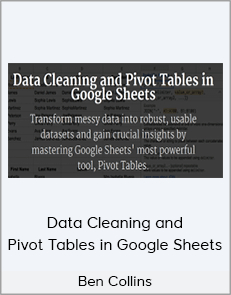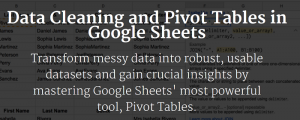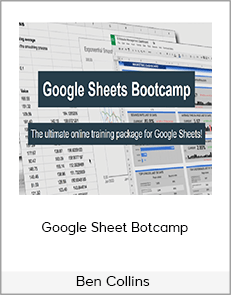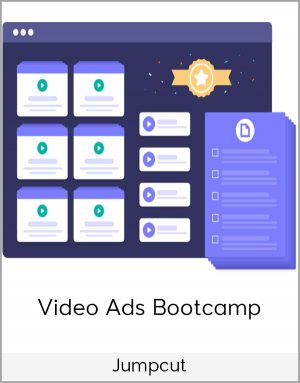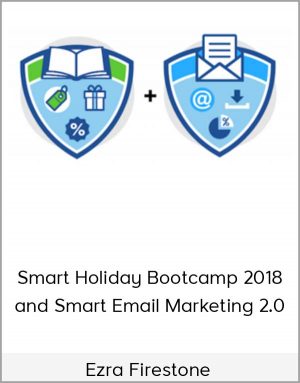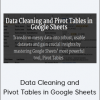Ben Collins – Data Cleaning and Pivot Tables in Google Sheets
$30.00$99.00 (-70%)
Tips and tricks, such as shortcut keys, to make your workflow more efficient.
Ben Collins – Data Cleaning and Pivot Tables in Google Sheets
Check it out: Ben Collins – Data Cleaning and Pivot Tables in Google Sheets
Transform messy data into robust, usable datasets and gain crucial insights by mastering Google Sheets’ most powerful tool, Pivot Tables.
There’s a joke in the data community that goes:
“You’ll spend 90% of your time cleaning data, and the other 10% of your time complaining about cleaning your data.”
Do you deal with badly formatted data that takes you hours to tidy up, preventing you from making progress on your “real” work?
Do you ever find yourself repeating a process manually, like extracting a zip code from an address?
Ever wondered what the heck a Pivot Table is, and why you should care about them?
This course is designed to help you work with messy, real-world datasets, and it’s a fit for beginner-to-intermediate level Google Sheets users.
Through four hours of video tutorials, you’ll learn techniques and best practices for cleaning data and preparing it for analysis and reporting — saving you hours of tedious, repetitive work, and helping you get accurate results for your company.
What is Data Cleaning?
Data cleaning is the process of identifying and correcting errors, fixing incomplete data or dealing with irrelevant data in your data sets.
The goal of data cleaning is to create a consistent, clean data set, which gives you the confidence that any subsequent analysis and conclusions you draw will be accurate and thorough.
Why should you care?
Data cleaning is a crucial first step in the data analysis pipeline, yet one that people often overlook.
If you start with “bad” data — if your data contains duplicate records for example — you’re inevitably going to end up with “bad” conclusions. You might end up double counting revenue, for example, which could have disastrous consequences for your business down the line.
This training course runs through professional techniques and best practices, using formulas and pivot tables, to clean your data, in a Google Sheets setting. Once you’ve grasped these concepts, you (and your boss!) will feel confident that your conclusions are based on sound data.
What this course covers
- Best practices for working with data in Google Sheets.
- All the formulas required for data cleaning.
- Tips and tricks, such as shortcut keys, to make your workflow more efficient.
- Professional techniques for turning messy real-world data into clean, orderly data sets for your analysis.
- Pivot Tables! This course covers Pivot Tables from top-to-bottom. Even if you’ve never seen a Pivot Table before, you’ll soon create cutting-edge ones, using advanced techniques like calculated fields and data extraction with special formulas. I don’t think you’ll find a more comprehensive course on Google Sheets Pivot Tables anywhere else on the web.
- Two in-depth case studies that show all these techniques being used together, in the wider context of a real-world problem.
What this course does not cover:
- How to analyze your datasets or how to build dashboard reports
- How to use the scripting language, Apps Script, to work with data.
- How to create data visualizations or charts from your data.
What you get with this course:
- Over 4 hours of video tutorials that walk you step-by-step through techniques for cleaning data and using pivot tables.
- Access to all the raw data files used in the examples, copies of the formulas and links to online documentation and other great resources.
- Membership to our dedicated Facebook group, where you can post questions and get answers, share insights and interact with other students.
- All the videos are online and you’ll have 24/7 access for life.
Who is this course for?
- Anyone who works with data in Google Sheets — maybe you’re a data analyst, a marketer, an educator, a scientist or someone in between.
- Anyones curious to learn more about working with data and Pivot Tables.
- Anyone who wants to learn best practices and how to be efficient with data.
- Anyone who wants to add new skills that will help you advance your career.
What are the prerequisites?
- A Google account.
- Access to Google Sheets.
- Basic familiarity with Google Sheets and spreadsheets.
- No assumptions are made about prior knowledge of functions or pivot tables — all the topics are covered comprehensively from scratch, at a comfortable pace.
Class Curriculum
Introduction
Lesson 1: Introduction to the Course (2:20)
Lesson 2: About the Instructor (3:25)
Lesson 3: How this Course is structured (1:50)
Join the Facebook group
Data Cleaning
Lesson 4: Introduction to Data Cleaning and Best Practices (5:12)
Lesson 5: Data Types (8:01)
Lesson 6: Handy Shortcuts for Data Tables (3:58)
Lesson 7: Find and Replace (7:19)
Lesson 8: Trim, Clean and Dealing with Spaces (1:58)
Lesson 9: Lower, Upper and Proper functions to deal with Case (2:35)
Lesson 10: Searching within data strings (5:08)
Lesson 11: Extracting data with Left, Right and Mid functions (11:26)
Lesson 12: Changing data with Substitute and Replace formulas (8:53)
Lesson 13: Splitting Data with Text to Columns (3:23)
Lesson 14: Bringing Data Together (4:42)
Lesson 15: Sorting and Filtering Data (8:59)
Lesson 16: Dealing with Null Values (9:09)
Lesson 17: Duplicates (7:07)
Lesson 18: Duplicates Formula Method (15:40)
Lesson 19: Using the IF function and logic to clean data (14:27)
Lesson 20: Using VLOOKUP to clean data (7:55)
Lesson 21: Spelling Tools and Transposing Data (5:32)
Pivot Tables
Lesson 22: Introduction to Pivot Tables (5:41)
Lesson 23: Pivot Table Fundamentals (11:09)
Lesson 24: Pivot Table Fundamentals II (7:29)
Lesson 25: Preparing Data for Pivot Tables (10:09)
Lesson 26: Advanced Pivot Table Features (Filters, Dates and Calculated Fields) (10:12)
Lesson 27: Show As Percentage (5:38)
Lesson 28: Pivot Table Options (5:32)
Lesson 29: Other uses for Pivot Tables (8:58)
Lesson 30: Getting data out of Pivot Tables the right way (7:57)
Data Cleaning & Pivot Tables Course Case Studies
Lesson 31: Case Study 1 Part I (18:09)
Lesson 32: Case Study 1 Part II (6:19)
Lesson 33: Case Study 2 Part I (13:38)
Lesson 34: Case Study 2 Part II (14:16)
Lesson 35: Case Study 2 Part III (6:23)

